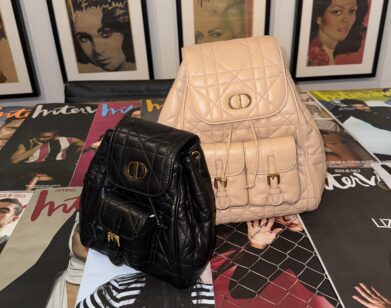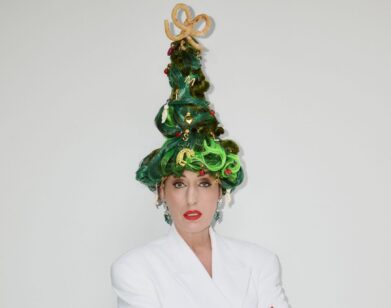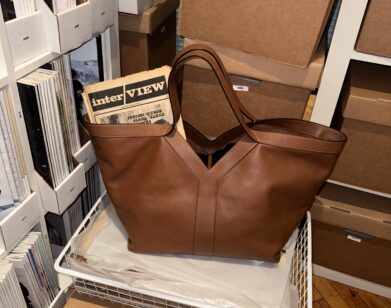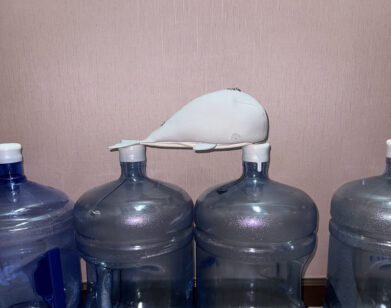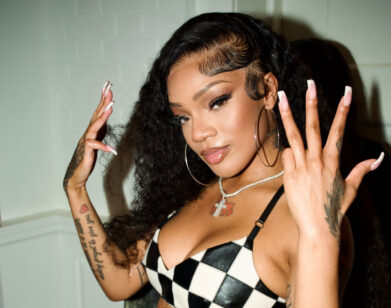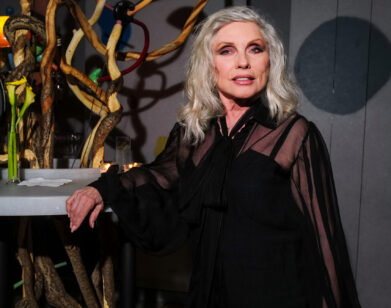Richard Quinn’s Textile Revolution
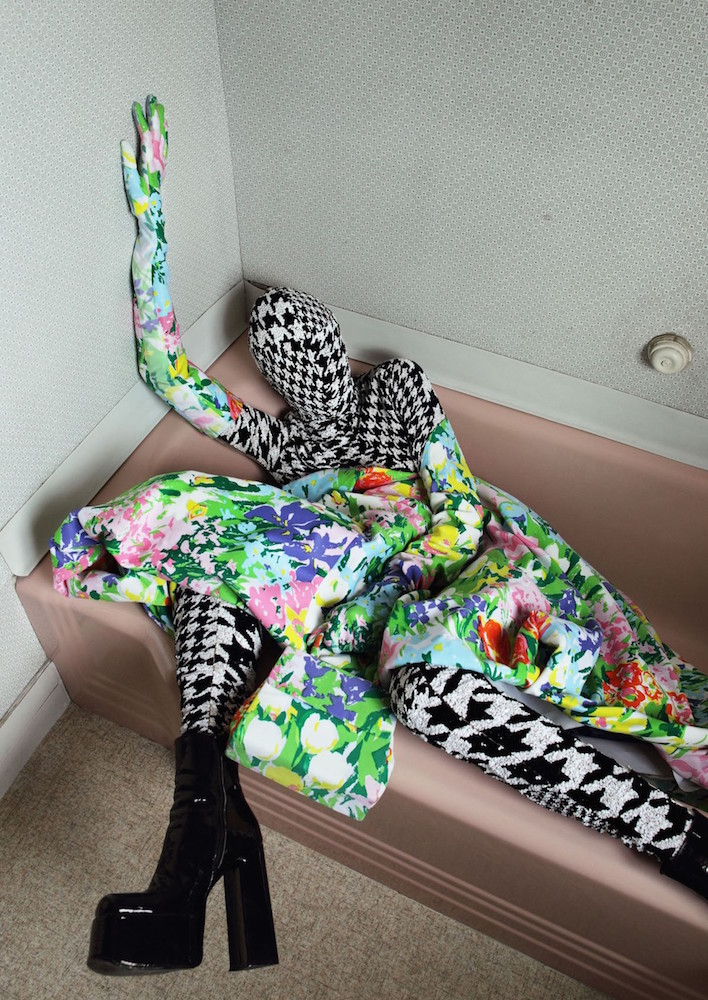
PHOTO COURTESY OF RICHARD QUINN AND NIKOLAY BIRYUKOV.
It’s a high-speed, competitive business out there for young fashion designers, but recent Central Saint Martins grad and textile extraordinaire Richard Quinn has earned his stripes—and plaids, and florals, and houndstooth. The 26-year-old was announced as the winner of the H&M Design Award 2017 last month, selected from eight other international finalists by a fashion-star-studded panel, directed by H&M’s creative advisor Ann-Sofie Johansson. Quinn’s prizes include approximately $53,000 for his brand, a one-year mentorship from H&M, and the opportunity to develop pieces for H&M stores next fall.
The star student and prince of prints enchanted the public with his MA collection at the Central Saint Martins Fall 2016 show, where models were not only draped in vivid floral evening gowns, foil jackets, and embroidered veils, but were also covered in Quinn’s own textiles from head to toe. Pieces from the collection have already appeared in numerous editorials for the likes of V, Dazed, and Vogue Italia, but it won’t be much longer before Quinn’s designs will appear on H&M customers around the world.
NATALIA BARR: What was it like to win the H&M Design Award Competition?
RICHARD QUINN: It was really good. It was really an experience, like you’re kind of in a bubble at Saint Martins, so to meet other people your age from different countries and backgrounds and different collections was really good. I think anyone could have won it, because everyone was so strong. It was nice to be amongst other creative people.
BARR: Have you always wanted to be a designer?
QUINN: I guess I was always creative. I always looked at photographs and stuff like that—Tim Walker’s photographs and the more dramatic photo shoots and fashion stories in magazines. POP magazine was a really influential magazine when I was around 15, 16, 17. It was more about recognizing things that created a world and realizing that I could do that.
BARR: Do you seek inspiration from other cultural mediums like music or film?
QUINN: I think music is always there, for everyone. No matter what you do, music is always going to be the fore focus. It’s such a quick tool. If you have music for a show, it sets the atmosphere straight away. That’s almost like a cheat, just to let everyone know what you’re thinking. I think that’s always going to inspire the collections. I really like Pet Shop Boys in terms of when I’m working—and the Cure, and a lot of the Smiths—stuff like that.
BARR: What was the first piece you ever designed?
QUINN: I think the first thing I actually made was on the fashion print pathway [at Saint Martins]. It was a pair of bright pink, fluffy trousers and they had these big cigarettes on them. [laughs]
BARR: I read that you worked at Dior and Richard James. Did those impact your designs at all?
QUINN: Definitely. You always have a strong point of view. Everyone at Saint Martins has a strong point of view in terms of ways of working, being really organized, and really breaking down an idea and presenting it in a clean way. I think that’s definitely what Dior taught me. I suppose at Richard James, it’s all about craft. At Dior I was in the design studio assisting, and helping with prints and all that kind of stuff, mainly with womenswear. At Richard James, it was more actually seeing the bespoke element of the clothes, so a mixture of craft and breaking down how to actually produce an idea.
BARR: What made you decide to cover your models in fabric?
QUINN: Everyone thinks it was originating from what Leigh Bowery did. There’s a guy who did it way before him in 1960 called Paul Harris. He basically made upholstered figures and covered them all in bright florals and different things like that. That’s where it manifested from. It has a dark edge to it, which I kind of did too. That kind of vibe with bright florals.
BARR: Was there a specific piece that served as a starting off point for the collection?
QUINN: Yes, the first kind of fashion object that I made that really kick-started the collection was the gloves. They’re like flat pack gloves. They’re heat pressed together and all different layers of stencils, and then you can wear them. They come alive when you put your hands in them. The mixtures of those fabrics, and those prints, and that kind of bold outline of the hands then translated into the obnoxiousness of the collection—it kind of kick-started it. [laughs]
BARR: How did you come up with the prints?
QUINN: All the prints are sourced from vintage fabric, and then I basically cut through them and added more flowers—like adaptions of old ’60s prints.
BARR: When you’re designing a piece, do you think about the garment and the structure of it first, or do you think of the prints first?
QUINN: I always think the textile informs the shape. I find something that I set out to achieve, like an overall look and an impact, and then you dissect. I think that’s why H&M liked me—you dissect so that there are actually very wearable pieces in there, but then it’s really styled up for that overall impact with the look. I definitely think they inform each other, sometimes you can do a really nice textile, and you think, “Ah, that would be great for a jacket or a trouser.” All kinds of things are roundabouts to get a vibe of each look or each style.
BARR: Was there something you wanted to tell people through your collection when you sent it down the runway?
QUINN: The main message, more on a technical level and on a textile level, was just to show each look had a different textile and a different impact. A fashion show shouldn’t just be the same idea all the way through. Especially as a graduate, to show what you can do, what looks, and the different layers to it. I’ve got the foil and the rose and the gold and stuff like that. You get all the different kinds of impacts.
BARR: What was the greatest challenge in designing that collection?
QUINN: I think trying to work out how the models are going to see. [laughs] The major thing was to actually screen-print all the fabrics in time with all the different fabrications. Some of them are painted. We’ve got this varnish and have to cure it for a few days. There are lots of technical things that you have to fit in.
BARR: Having designed pieces that have mainly existed on the runway and for fashion editorials, how is that going to translate into pieces for H&M?
QUINN: I just came back from Stockholm actually, and the pieces that they’re creating are basically the same as the collection. The more you style up, the more fantasy the clothes become. But when you actually strip it back, the embroidery end of the dress, that’s going to be separates. The element and the spirit are still there. Stuff like the floral dress, that’s almost the exact same for production, so they’re definitely taking a risk on some things. I think that’s why they wanted it, because it’s so different. It becomes an actual designer collaboration.
BARR: What does sustainability mean to your brand?
QUINN: I had the MA scholarship from Stella McCartney. My BA collection idea was that you could make something out of nothing. You didn’t have to have any animal byproducts in it, so it was all hand-painted canvas. They picked up on that idea and wanted to help sponsor my MA. They do talks and lectures at Saint Martins all about ethical thinking and the best ways of producing a collection, and just being aware of your environment. I think in 2016, you should be an ethical company. I don’t think anyone should suffer just because you want to dye something pink. [laughs] It’s so ridiculous. I love bringing the craft back to London. Clients can actually come to the studio and see where their clothes are made. Nothing is sent out. I find it brings more of a life to the garment as well. Also, H&M is really good. They’ve got their Conscious Collection, and the collection they’re producing in collaboration with me is gonna be all ethical as well, all ethically sourced and produced, so that’s pretty amazing.
FOR MORE ON RICHARD QUINN, VISIT HIS WEBSITE.

